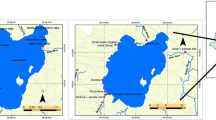Abstract
In recent years, there have been increasing concerns about the possible contamination of freshwater resources by residues of agrochemicals used on agricultural lands. These concerns stem from the awareness that maintaining the quality of the natural resource base is crucial for sustaining agricultural productivity as well as social progress. However, very little is known about how pesticides used in intensive irrigated rice culture systems, which are practiced in over 40 million hectares in Asia, affect the quality of freshwater resources that receive the excess water from these systems.
Access this chapter
Tax calculation will be finalised at checkout
Purchases are for personal use only
Preview
Unable to display preview. Download preview PDF.
Similar content being viewed by others
References
ADB—Asian Development Bank. 1987. Handbook on the use of pesticides in the Asia-Pacific region. Manila, Philippines: ADA.
Castañeda, A.R., and S.I. Bhuiyan. 1991. Nitrate-nitrogen concentrations in shallow ground-water underneath ricefields. Philippine Journal of Crop Science 16(2): 57–62.
Cheng, H.H. 1990. Pesticides in the soil environment: processes, impacts, and modeling. Madison, Wis., USA: Soil Science Society of America.
Department of Environment and Natural Resources (DENR). 1990. DENR Admin. Order No. 34, Series of 1990. Quezon City, Philippines.
Edwards, C.A. 1974. Pesticides in soil and water. Madison, Wisconsin, USA: Soil Science Society of America, Inc.
FAO/WHO—Food and Agriculture Organization/World Health Organization 1970. Pes-ticide residues in food. WHO Technical Report Series 474. Rome: FAO/WHO.
Hallberg, Q.R. 1987. Agricultural chemicals in groundwater: extent and implication. American Journal of Alternative Agriculture 2(1).
Henderson, C., W.L. Johnson, and A. Inglis. 1969. Organochlorine insecticide residues in fish. Pesticide Monitoring Journal 3: 145–171.
Hicks, D.W., L.E. Asmussen, and H.F. Perkins. 1987. Soil and geohydrologic relations on a southern Coastal Plain watershed. Agronomy Abstracts (p. 27). Madison, Wis., USA: America Society of Agronomy.
Hunter, R.G., J.H. Carroll, and J.C. Randolph. 1980. Organochlorine residues in fish of lake Texoma. Pesticide Monitoring Journal 14: 102–107.
Johnson, D.W., and S. Lew. 1970. Chlorinated hydrocarbon residues in representative fishes of southern Arizona. Pesticide Monitoring Journal 4: 57–61.
Lawrence, A.R., and S.S.D. Foster. 1987. The pollution threat from agricultural pesticides and industrial solvents: A comparative review in relation to British aquifers. Hydrogeological report of the British Geological Survey no. 87/2. Oxfordshire, Wallingford.
Leistra, M., and J.J.T.I. Boesten. 1989. Pesticide contamination of groundwater in west-ern Europe. Agriculture,Ecosystems, and the Environment 26: 369–389.
Lim, G.S., and S.H. Ong. 1977. Pesticide benefits and side effects. Southeast Asian Workshop in Pesticide Management, Bangkok, Thailand.
Metcalf, R.L., G.K. Sangha, and I.P. Kpoor. 1971. Model ecosystem for the evaluation for pesticide biodegradability and ecological magnification. Environmental Science and Technology 5: 709.
NPCC—National Pollution Control Commission. 1978. Water usage and classification. NPCC Rules and Regulations. Manila, Philippines.
NRC—National Research Council. 1977. Drinking water and health. Washington, D.C.: National Academy of Sciences.
Pionke, H.B., D.E. Glotfelty, A.D. Lucas, and J.B. Urban. 1988. Leaching of carbofuran in flooded field under puddled and unpuddled conditions. Journal of Environmental Science and Health 23(3): 225–234.
Punla Foundation. 1981. Rural poverty series. Quezon City, Philippines: Punla.
Rola, A.C., and P.L. **ali, 1993. Pesticides, rice productivity, and farmers’ health: An economic assessment. Los Baños, Laguna, Philippines: International Rice Re-search Institute, Washington, D.C.: World Resources Institute.
Schmitt, C.J., J.L. Ludke, and D.F. Walsh. 1981. Organochlorine residues in fish: National pesticide monitoring program. Pesticide Monitoring Journal 14: 136–155.
Spalding, R.F., G.A. Junk, and J.J. Richard. 1980. Pesticides in groundwater beneath irrigated farmlands in Nebraska. Pesticide Monitoring Journal 14(2): 70–73.
Stucky, N.P. 1970. Pesticide residues in channel catfish from Nebraska. Pesticide Moni-toring Journal 4: 62–66.
Tejada, A.W., and E.D. Magallona. 1986. Pollution potential of pesticides in agriculture: Rice-fish-livestock farming. Proceeding of the fifteenth Convention of Los Baños Chapter of the Chemical Society of the Philippines. Los Baños, Laguna, Philippines: Chemical Society.
Vermeer, K., R.W. Risebrough, A.L. Spaans, and L.M. Reynolds. 1974. Pesticide effects on fishes and birds in ricefields of Surinam, South America. Environmental Pollution 7: 217–236.
Wartenberg, D. 1988. Groundwater contamination by temik aldicarb pesticide: The first eight months. Water Resources Research 24(2): 185–194.
WQA—Water Quality Association. 1991. Recognized treatment techniques for meeting the national primary drinking water regulations with the application of point-ofsource systems. Lisle, Ill., USA: WQA National Headquarters and Laboratory.
Editor information
Editors and Affiliations
Rights and permissions
Copyright information
© 1995 Springer Science+Business Media New York
About this chapter
Cite this chapter
Bhuiyan, S.I., Castañeda, A.R. (1995). The Impact of Ricefield Pesticides on the Quality of Freshwater Resources. In: **ali, P.L., Roger, P.A. (eds) Impact of Pesticides on Farmer Health and the Rice Environment. Natural Resource Management and Policy, vol 7. Springer, Dordrecht. https://doi.org/10.1007/978-94-011-0647-4_7
Download citation
DOI: https://doi.org/10.1007/978-94-011-0647-4_7
Publisher Name: Springer, Dordrecht
Print ISBN: 978-94-010-4282-6
Online ISBN: 978-94-011-0647-4
eBook Packages: Springer Book Archive




